You know that moment when you’re driving through a neighborhood and suddenly you slow down because one house just stops you in your tracks?
It’s usually not the fancy architecture or expensive landscaping that catches your eye – it’s that perfect flower bed right in front that makes the whole place come alive.
I’ve been obsessed with front yard flower beds lately, probably because mine looks like a sad patch of dirt with a few struggling petunias.
But here’s the thing: creating a stunning flower bed doesn’t require a landscaping degree or a massive budget.
Whether you’ve got a tiny strip by your walkway or a sprawling front lawn begging for color, the right combination of plants can completely transform your home’s curb appeal.
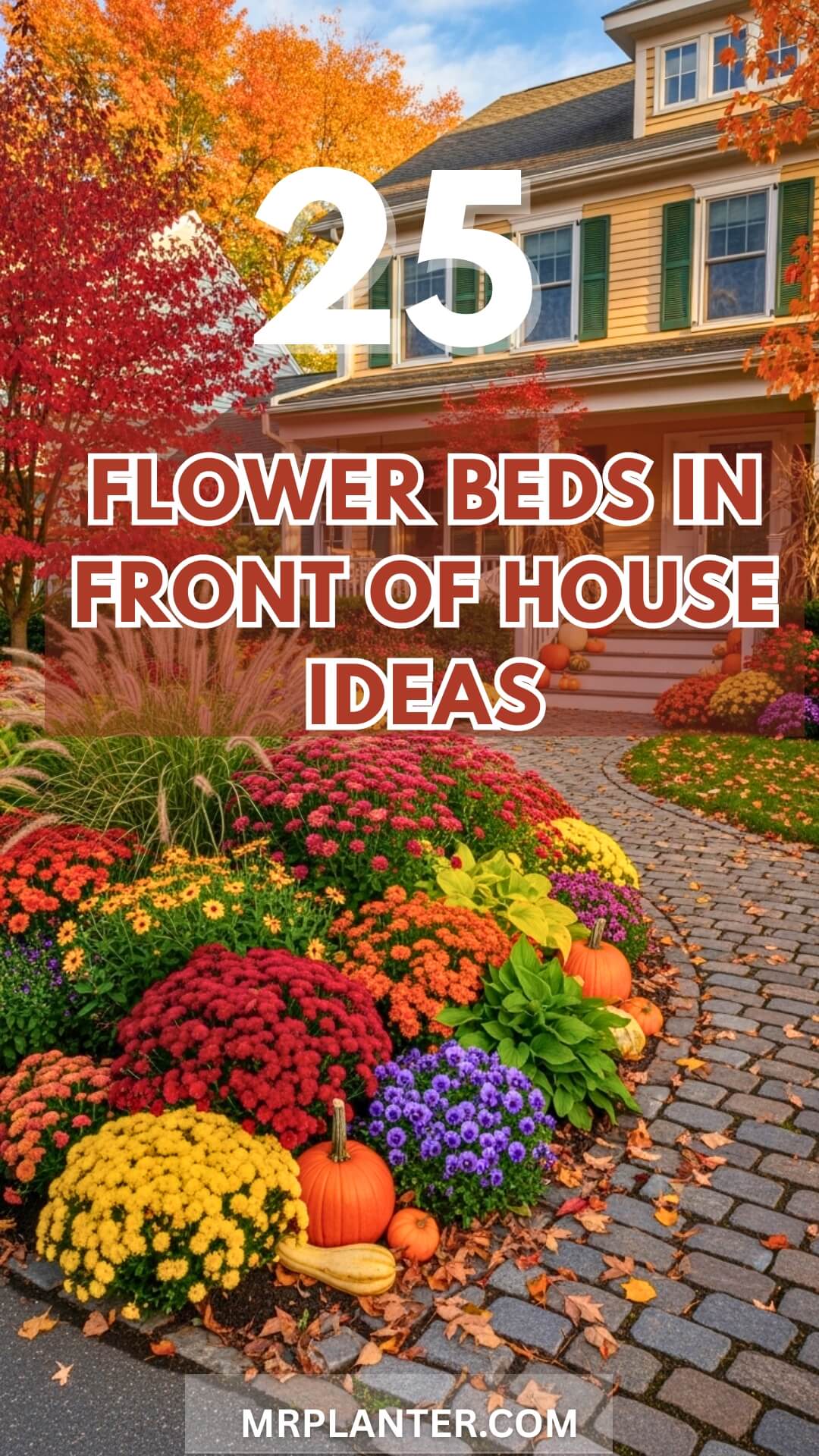
I’ve rounded up 21 gorgeous flower bed ideas that’ll have your neighbors doing double-takes and asking for your secret.
Trust me, your front yard is about to become the talk of the street.
1. Bleeding Hearts
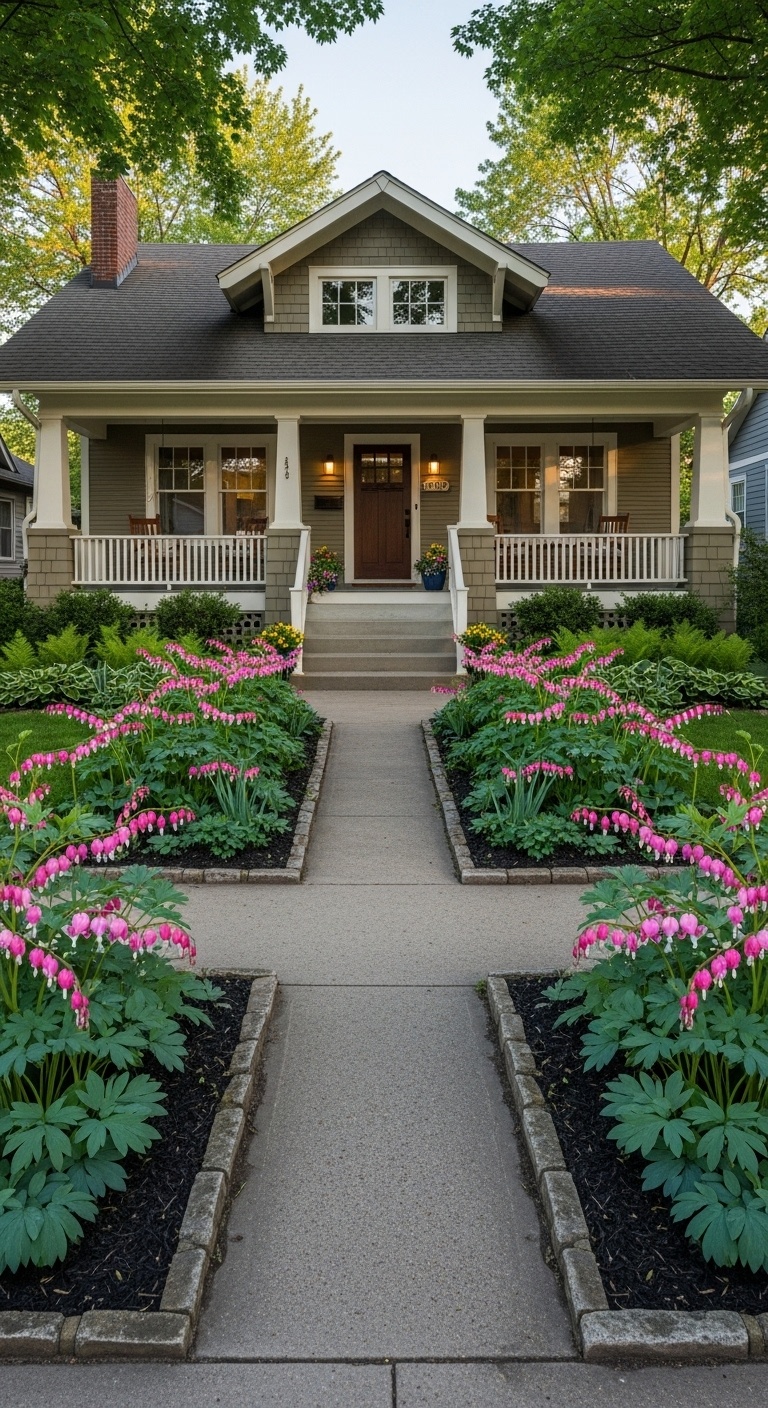
Bleeding Hearts (Dicentra spectabilis) are an excellent choice for adding early spring elegance and unique blooms to your front yard flower beds.
These enchanting plants are known for their distinctive heart-shaped flowers, which typically appear in shades of pink, red, or white, gracefully dangling from arching stems.
They thrive in partial to full shade and prefer consistently moist, well-drained soil, making them ideal for areas where many sun-loving flowers struggle.
Bleeding Hearts can create a delicate and romantic atmosphere in your garden and pair beautifully with other shade-loving perennials. Keep the soil evenly moist, particularly during their blooming season, to ensure a stunning display.
“For a truly captivating and unique early spring show in shaded areas, consider the charming blooms of Bleeding Hearts.”
2. Daylilies
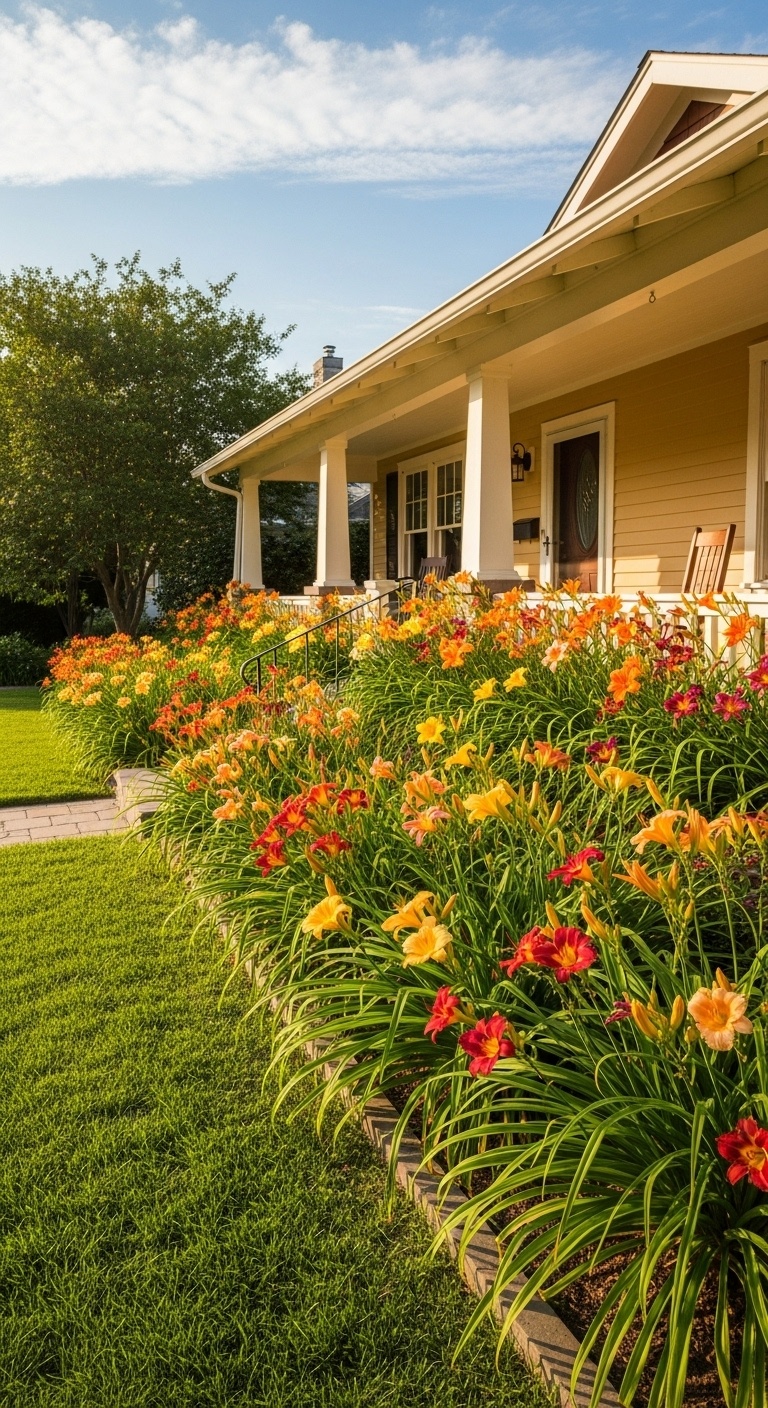
Daylilies are a fantastic choice for flower beds in front of your house. They come in many colors and bloom from spring to late summer, giving you vibrant flowers for a long time.
These plants are hardy and can thrive in different kinds of soil. They also require minimal care, making them perfect for busy homeowners. Just make sure they get enough sunlight.
When planting daylilies, space them about 18 to 24 inches apart. This allows them to grow without crowding. Water them regularly, especially during dry spells.
Daylilies are also great for borders or mixed flower beds. They pair well with other plants and look beautiful in any garden style.
“Plant daylilies in well-drained soil for the best results. They thrive on neglect, so don’t overwater!” – MrPlanter.
3. Peonies
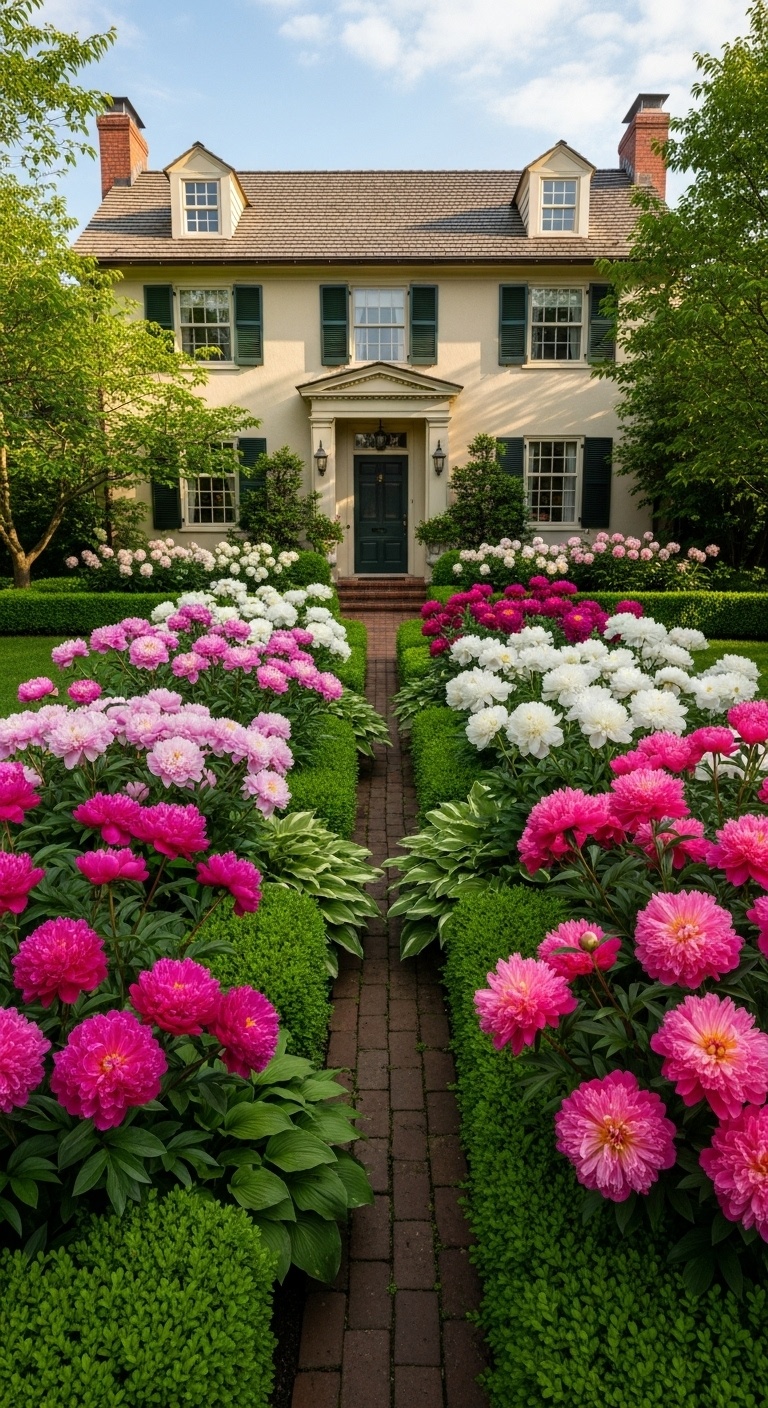
Peonies are a fantastic choice for your front yard. These flowers bloom beautifully, adding color and style to your home. They come in different shades like pink, white, and red, making it easy to find the perfect match for your garden.
Plant peonies in a sunny spot for the best results. They thrive in well-drained soil, so make sure to prepare the ground properly. These flowers are not only pretty, but they’re also low-maintenance once established.
You can mix peonies with other flowers for a vibrant display. They pair nicely with annuals and perennials, creating a lively look throughout the growing season.
“Always plant peonies in groups for maximum impact. Trust me, you’ll love the way they brighten up your space!” — MrPlanter
4. Hydrangeas
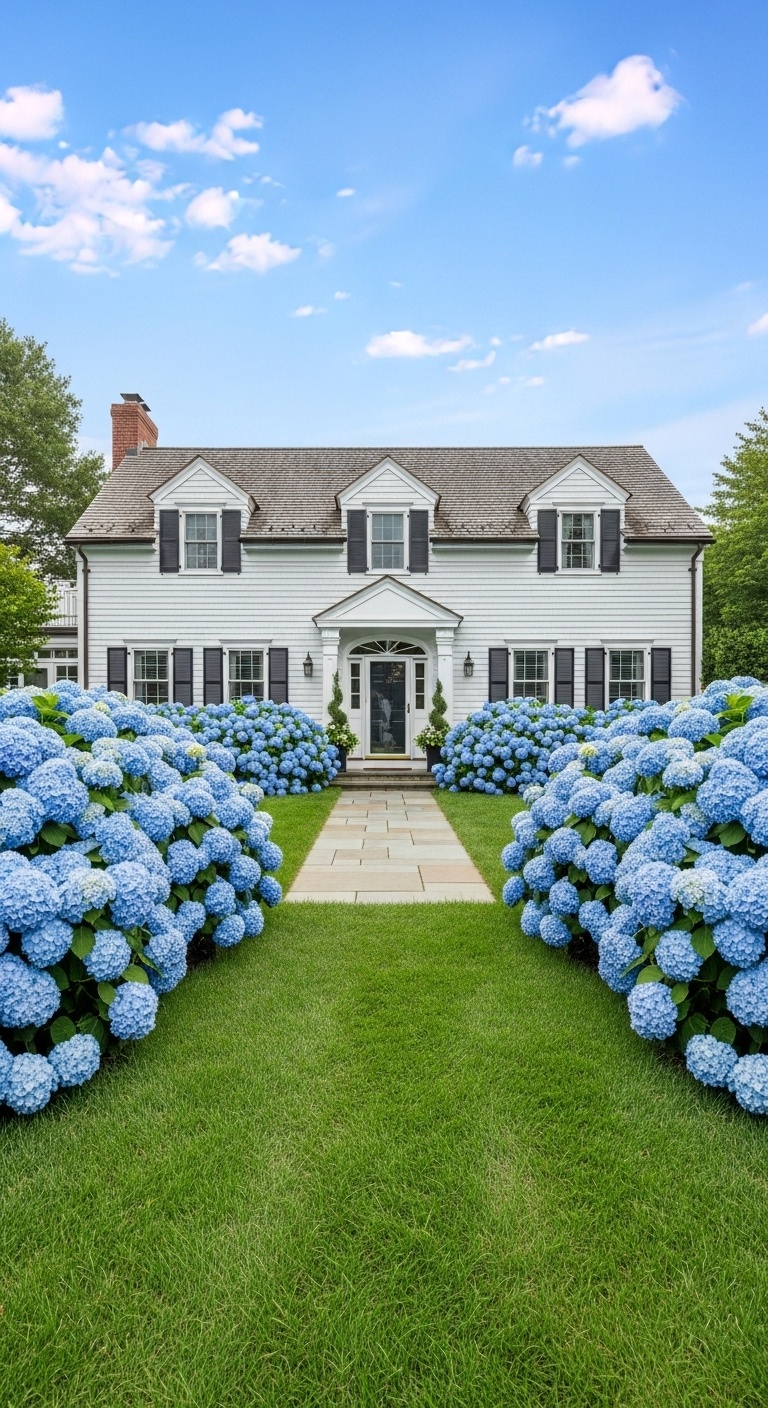
Hydrangeas can add a beautiful touch to your front flower beds.
They come in different types, so you can choose colors that match your home. Make sure you plant them in a spot where they get morning sun and some afternoon shade.
These plants grow quickly, filling gaps in your garden nicely. Depending on the variety, they can reach heights of up to 15 feet.
For the best results, space them about 3 to 4 feet apart. Remember to water them well, especially in the first few years. A deep soak once or twice a week helps their roots thrive.
“Hydrangeas need a consistent water supply. Keep them hydrated and watch them bloom!” — MrPlanter
5. Lavender
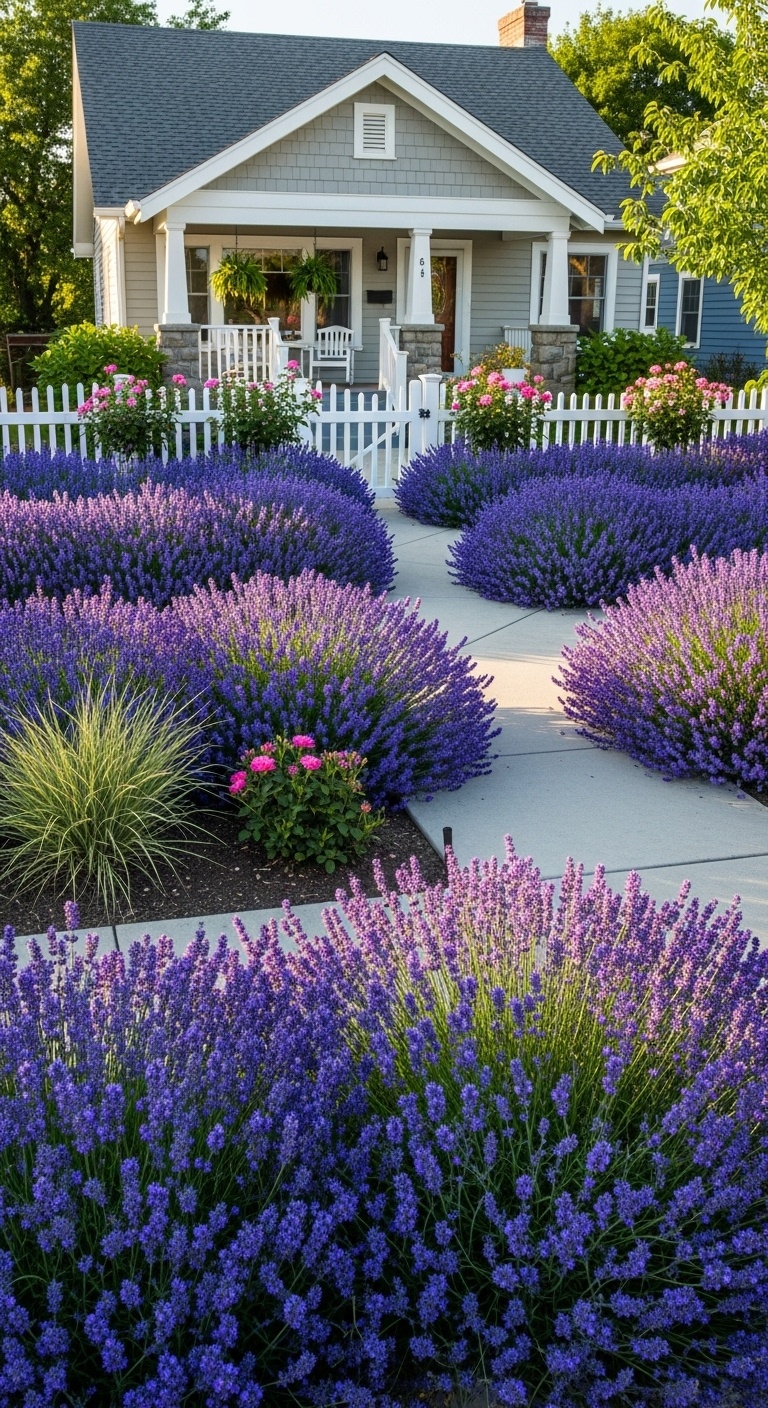
Lavender adds lovely color and a pleasant scent to your front yard. It’s easy to grow and attracts bees and butterflies, which helps your garden thrive.
You can plant lavender in beds on its own or mix it with other flowers. It looks great alongside perennials and even makes a nice border.
Consider planting lavender under trees to fill empty spaces. This creates a layered look that adds depth to your garden.
Make sure to pick a sunny spot. Lavender loves sunlight and well-drained soil for the best growth. Water it well, but don’t let it sit in water.
“For the best blooms, cut back your lavender plants in early spring. This keeps them healthy and looking their best.”
6. Roses
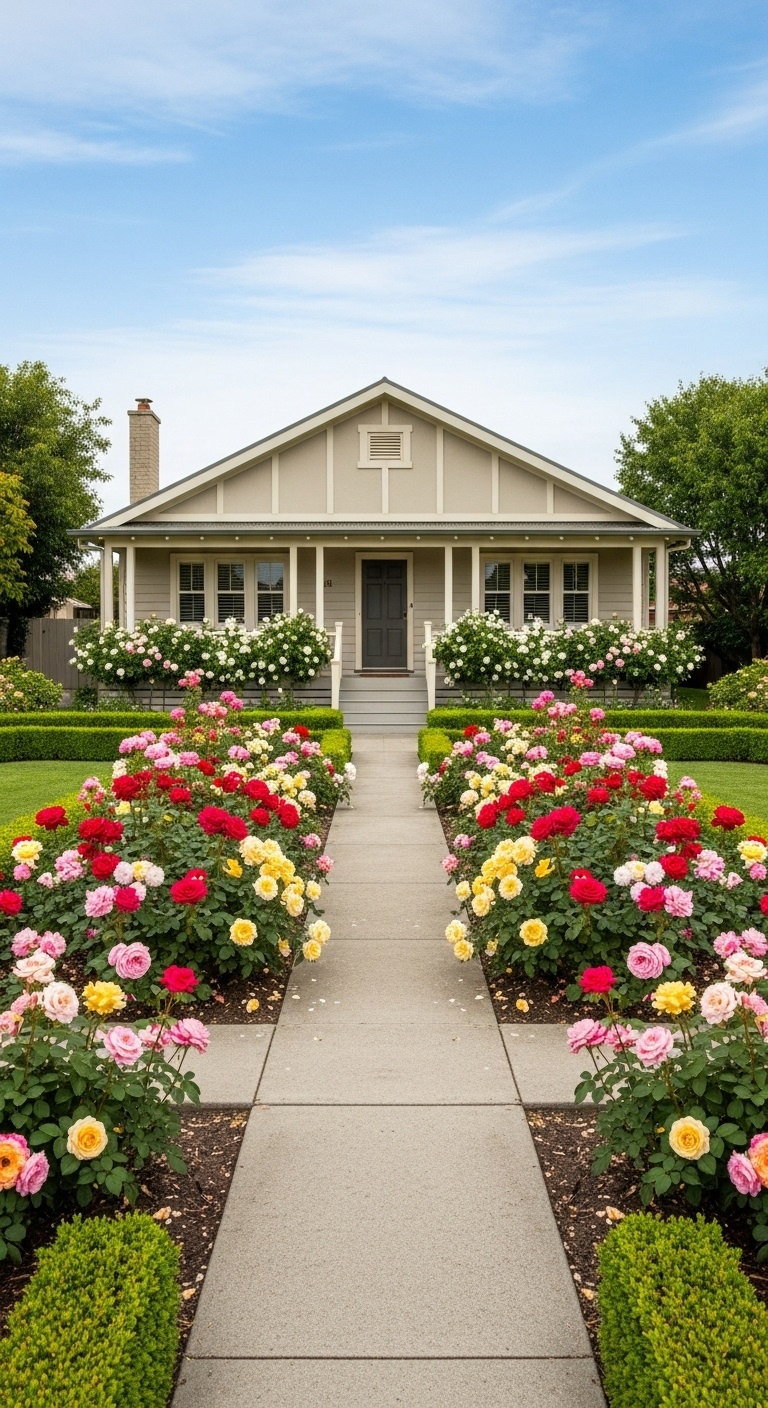
Roses add classic beauty to your front yard flower beds. They come in many colors and types, making it easy to find one that fits your style.
When planting roses, choose a sunny spot. They thrive in at least six hours of sunlight each day. Good drainage is also important to keep the roots healthy.
Regular watering helps, especially in hot weather. Aim for deep watering once a week. This encourages strong root growth.
Pruning your roses in the early spring keeps them healthy. Remove dead or weak branches to allow better airflow. Fertilizing in the spring helps promote vibrant blooms.
Combining roses with other plants can enhance their beauty. Pair them with colorful annuals or fragrant herbs for a charming display.
“It’s best to plant roses early in the season,” says MrPlanter. “This gives them enough time to establish themselves before the heat comes.”
7. Tulips
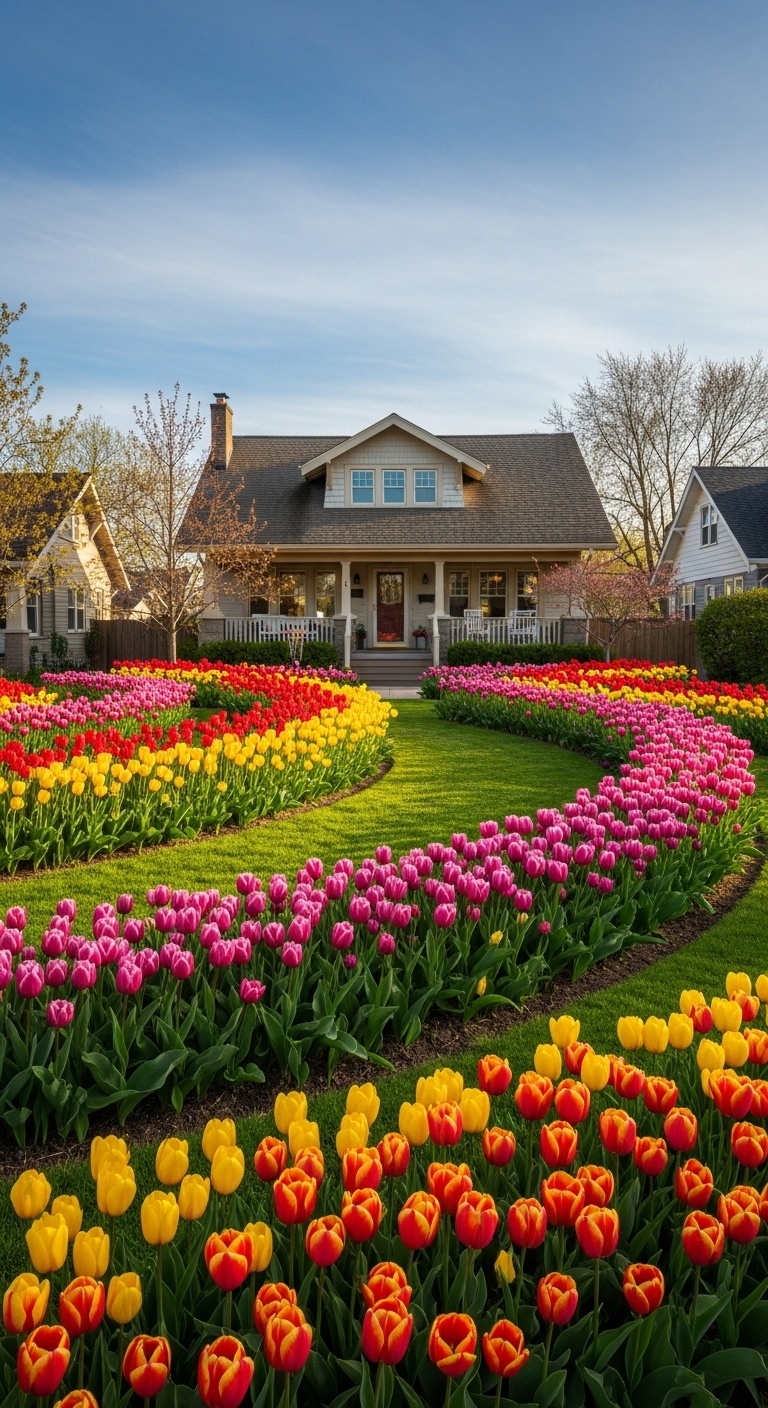
Tulips are a fantastic choice for front yard flower beds. They come in many colors, making it easy to create a vibrant and inviting entrance to your home.
Plant them in clusters for a striking effect. You can mix different colors or stick to one for a more uniform look. They bloom in spring, so they can brighten up your yard after winter.
Tulips prefer well-drained soil and a sunny spot. Make sure to water them regularly, especially during dry spells. They are perennials, meaning they come back year after year.
Don’t forget to remove spent blooms to encourage new growth. This keeps your tulips looking fresh and lively throughout the flowering season.
“For best results, plant tulips in groups of five or more. This creates a bolder look that enhances your garden’s appeal,” says MrPlanter.
8. Daffodils
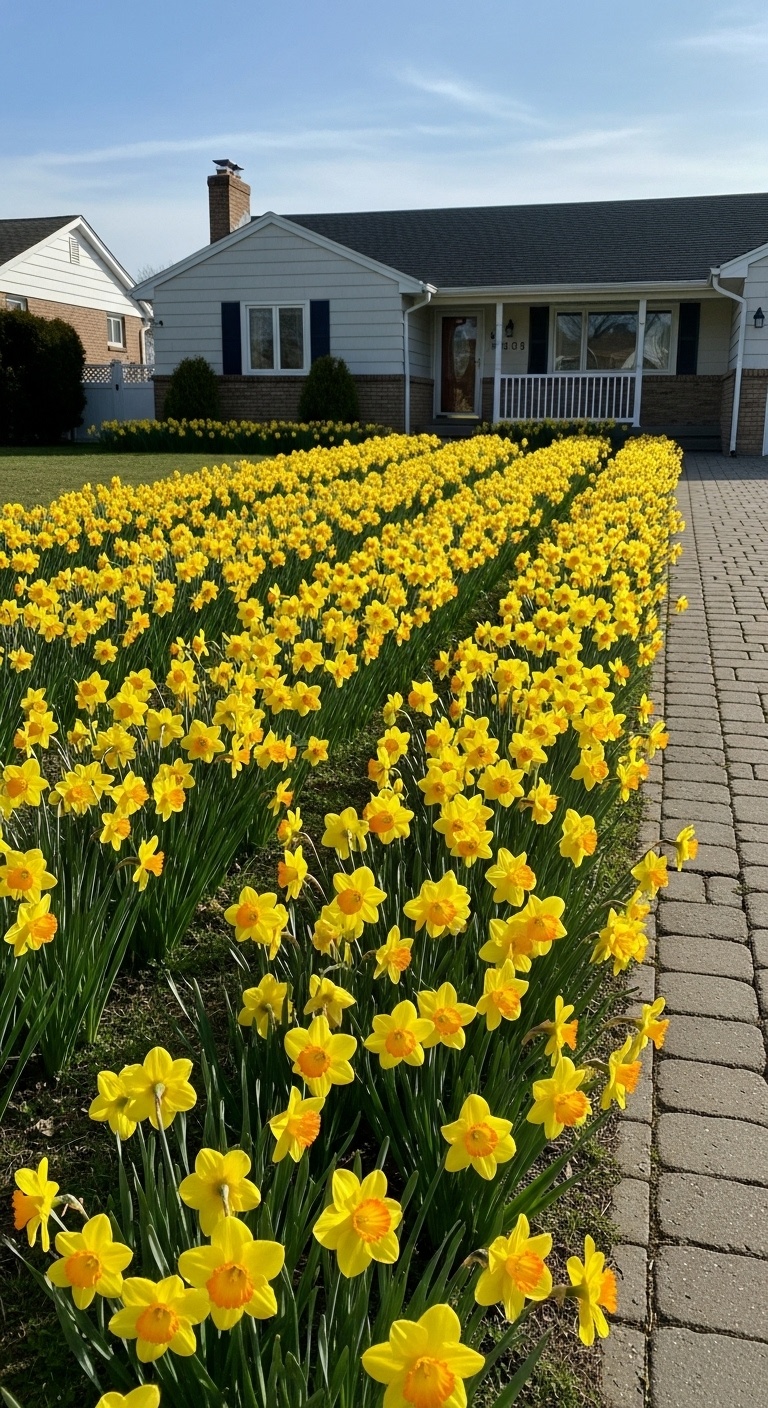
Daffodils are a great choice for your front yard. Their bright yellow flowers can lift your spirits in early spring. They’re among the first blooms to pop up, adding cheerful color after winter.
These flowers grow well in full sun or partial shade. They prefer well-drained soil and are very easy to care for. Plus, once planted, they often come back year after year.
Daffodils also deter deer and rabbits, making them a smart pick for your garden. You can plant them in groups for a stunning splash of color.
“Plant your daffodils in clusters for a bolder look. They thrive in various climates, so don’t worry about where you live!”
9. Lilies
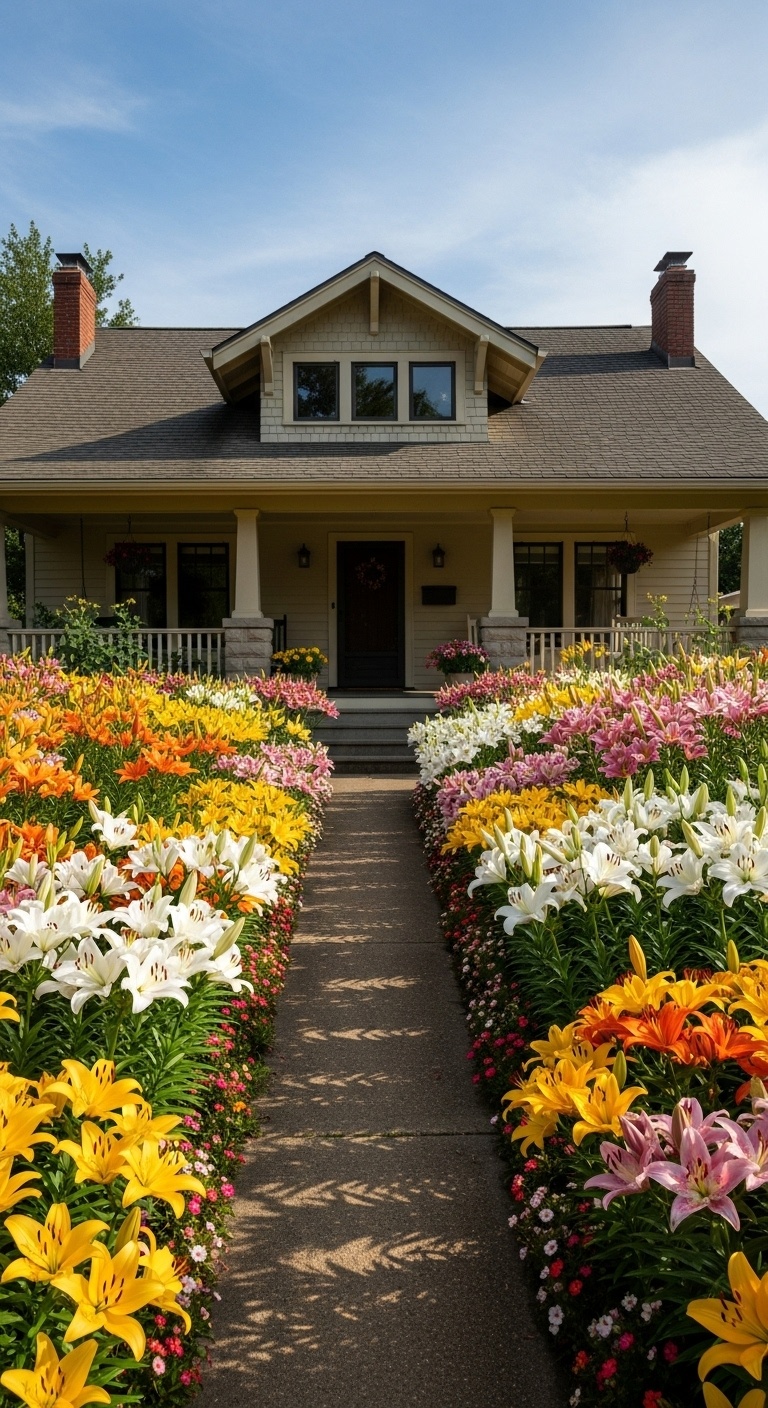
Lilies are a great choice for your front flower bed. They come in many colors and sizes, adding beauty to any garden.
These flowers thrive in sunlight and can grow well in various soil types. Just make sure to water them regularly, especially in dry spells.
You can mix lilies with other flowers for a vibrant look. They pair well with daisies and tulips for a stunning display.
With their tall stems and lovely blooms, lilies can be a focal point in your garden. Easy to grow, they can attract butterflies and bees too.
“Plant your lilies in clusters for a more impactful look. They bloom in summer, so you’ll have color when it’s needed most.” – MrPlanter
10. Marigolds
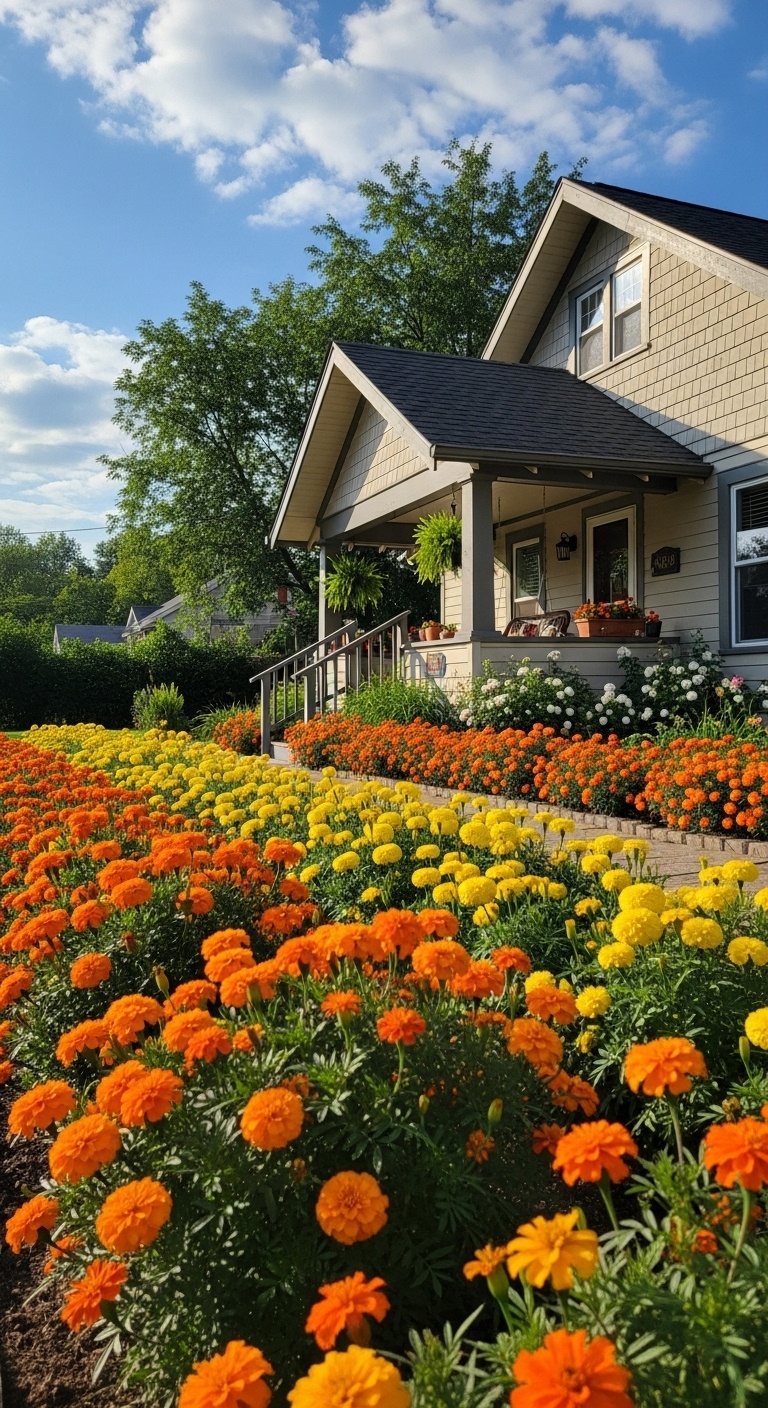
Marigolds are a great choice for your flower bed. They come in bright colors like yellow, orange, and red, which can make your front yard pop.
These flowers are easy to grow and can thrive in most conditions. They attract butterflies and can even help keep pests away from other plants.
Planting marigolds in rows can create a cheerful look in your garden. You can mix them with other flowers for extra color and variety.
“Plant your marigolds in full sun for best growth. Regular watering will keep them blooming all season long.”
11. Begonias
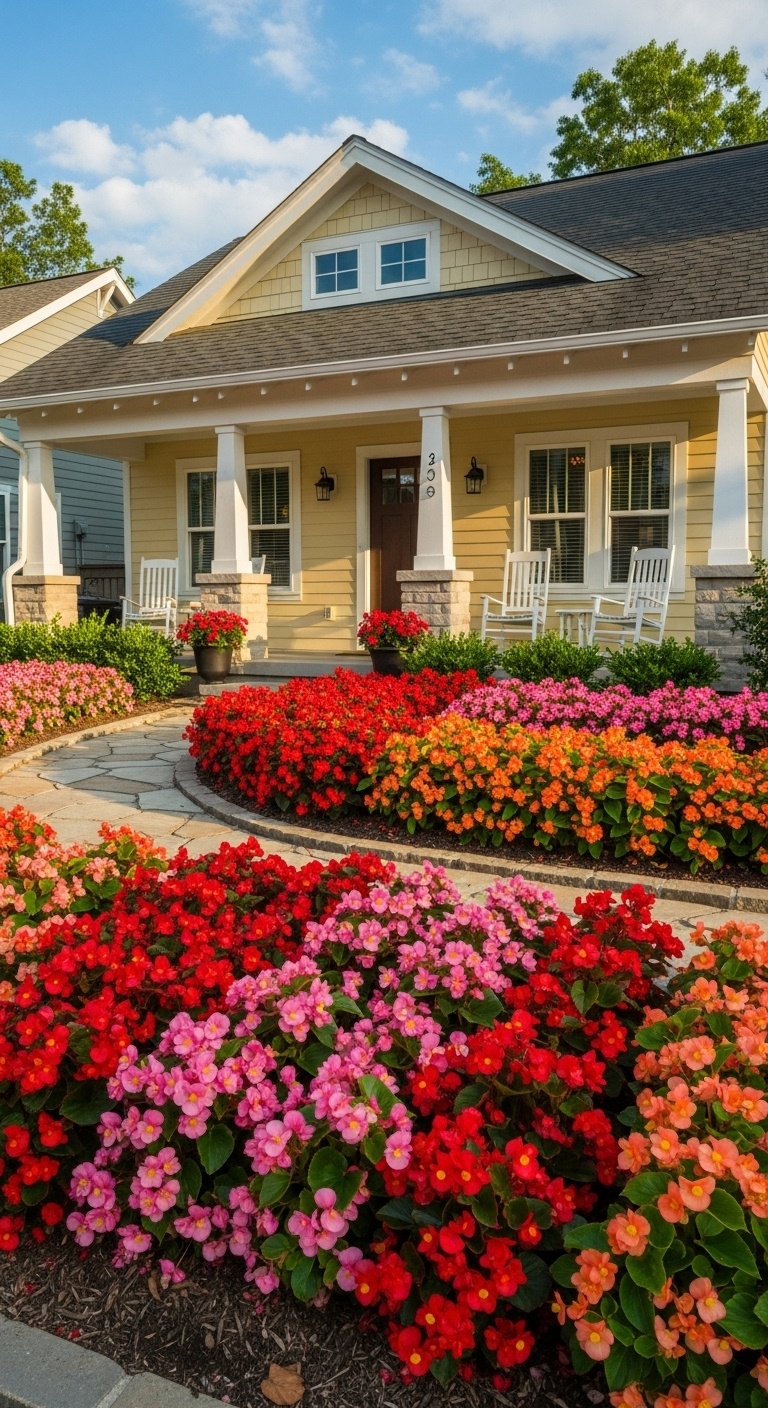
Begonias are a fantastic choice for your front flower beds. Their bright flowers and unique leaves add color and texture. They thrive in shaded areas, making them perfect for spots that don’t get direct sunlight.
When planting begonias, make sure the soil is well-drained. They prefer slightly moist conditions, so water them regularly, but avoid overwatering. Using organic mulch can help keep the soil moist and reduce weeds.
These plants can also be great in containers or hanging baskets, adding beauty to any space. Choose from various types, including tuberous and fibrous begonias, to match your style.
“Plant begonias in a spot with filtered light. They’ll reward you with vibrant blooms all season long!”
12. Petunias
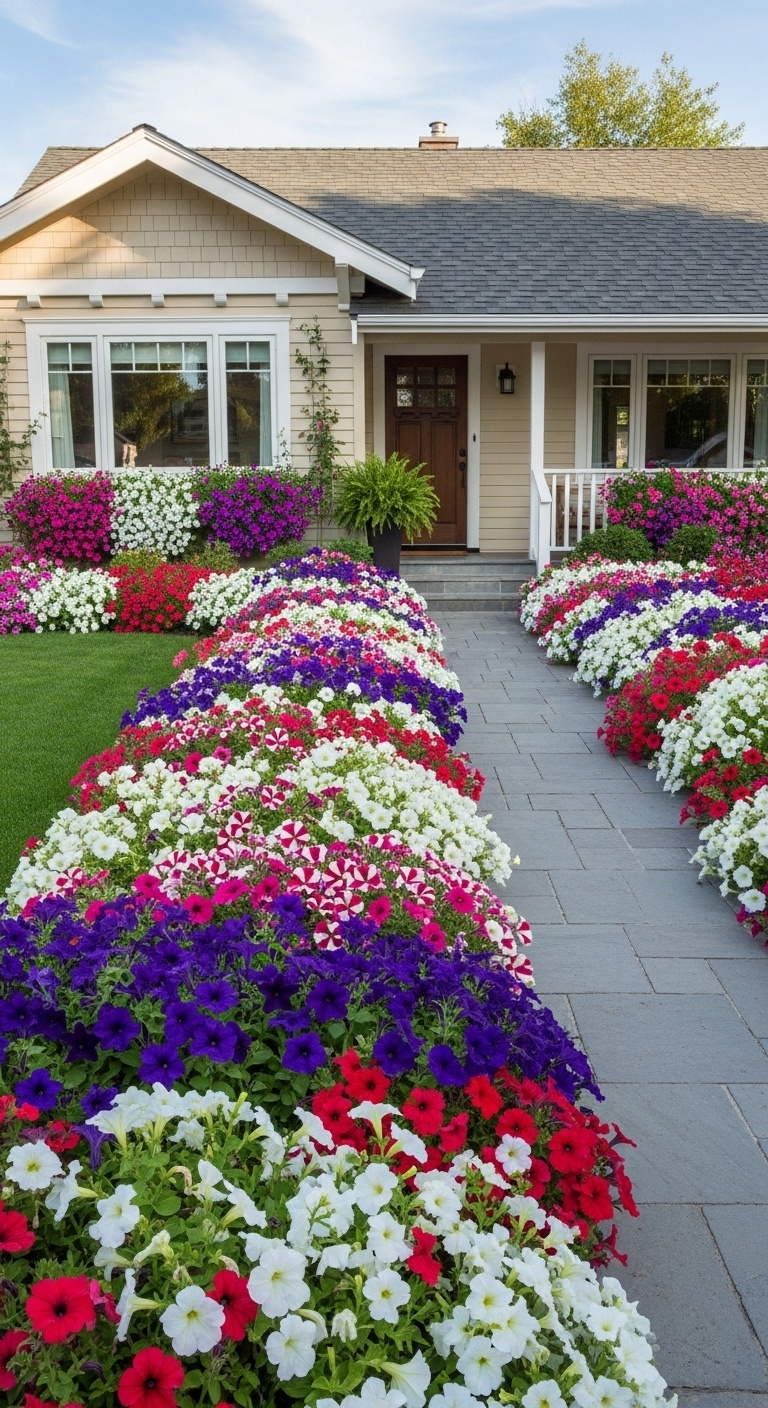
Petunias are a great choice for your front yard flower beds. They come in many colors, making it easy to match your home’s style. These flowers bloom all summer, adding bright spots of color.
You can mix petunias with other flowers for a vibrant look. They pair well with marigolds or can stand alone in beds. Plant them in groups for a fuller effect.
Consider using tall planters with cascading petunias for a modern touch. This can work well at your entryway. Hanging baskets are another fun way to display these flowers.
Petunias are relatively easy to care for and add charm to any yard. Be sure to water them regularly, especially in hot weather.
“Plant petunias in well-drained soil to keep them healthy. A little deadheading will encourage more blooms throughout the season!” – MrPlanter
13. Zinnias
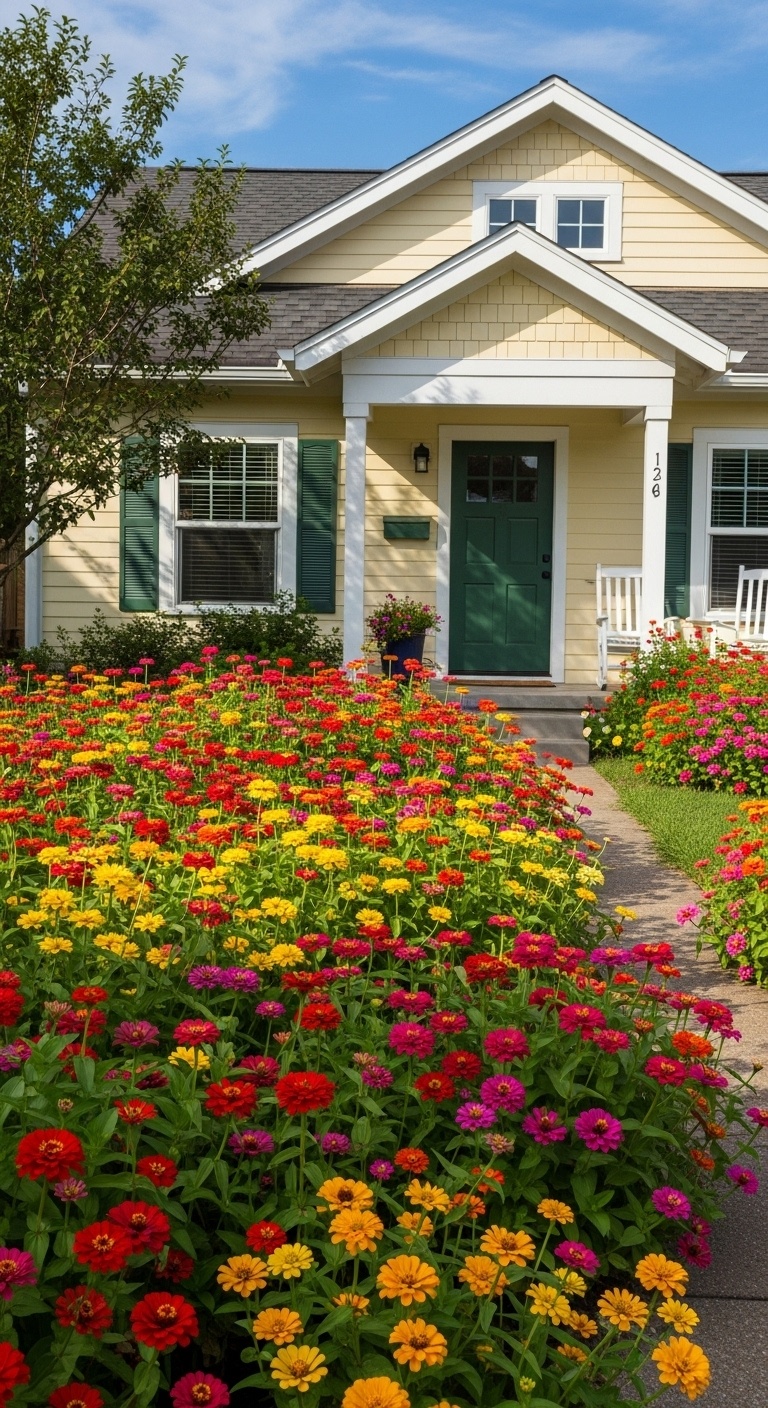
Zinnias are a great choice for your front flower bed. They come in many bright colors and can really brighten up your yard. These flowers bloom all summer and are easy to care for.
You can plant zinnias from seeds or buy young plants. They thrive in full sun, so pick a spot that gets lots of light. They also attract butterflies and bees, making your garden lively.
Zinnias do well in pots too. If you have space, consider putting them in window boxes or on your porch. This way, you can enjoy their colors up close.
To keep your zinnias healthy, water them regularly but don’t overdo it. Remove any dead flowers to encourage new blooms.
“Choose a mix of zinnia varieties for more color and interest. Zinnias are low-maintenance, making them a perfect option for busy gardeners.” — MrPlanter
14. Geraniums
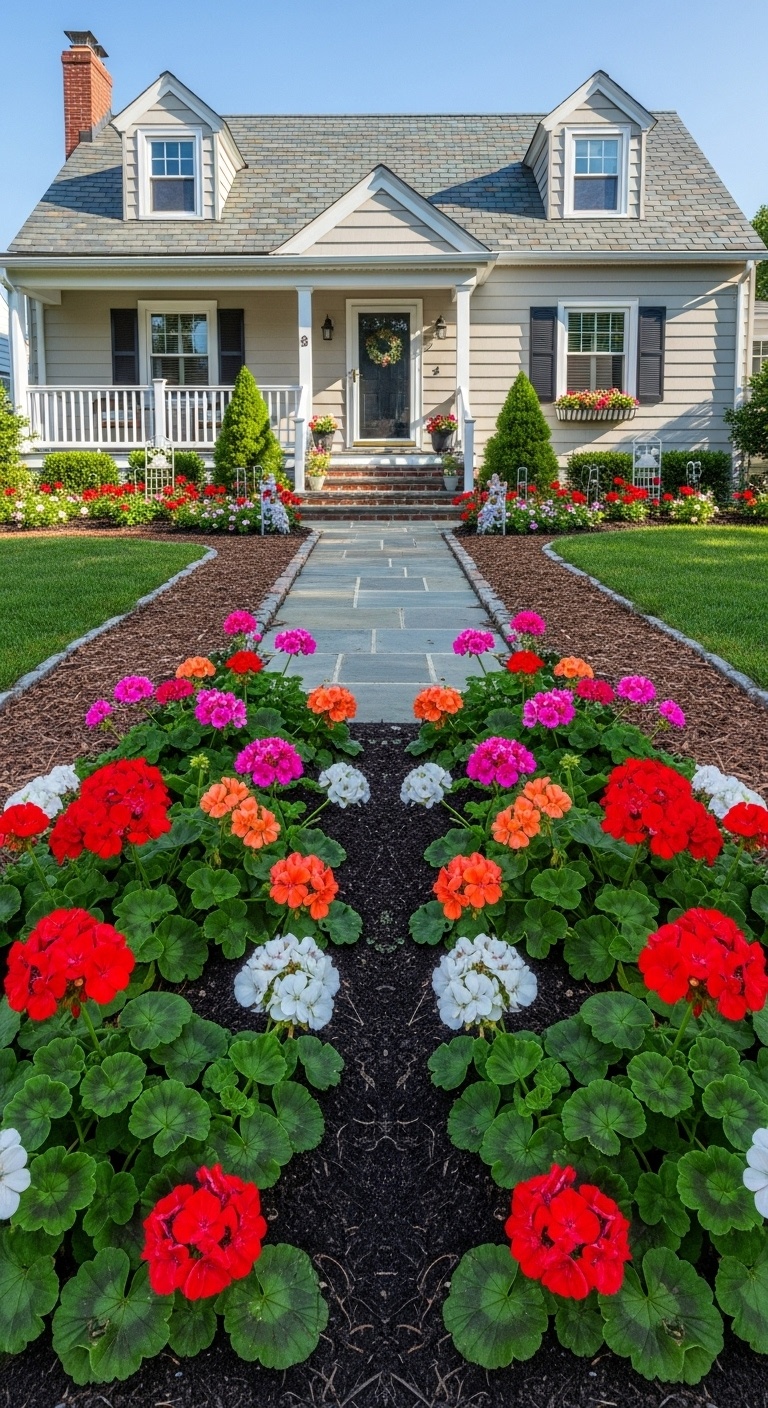
Geraniums are a great choice for your flower beds. They come in many varieties and bloom throughout the spring and summer. These flowers can brighten up any space with their vibrant colors.
You can plant geraniums alongside other low-growing plants or evergreen shrubs. They make excellent borders and add a nice touch to your garden design.
These hardy plants often don’t need much maintenance. They can thrive in various conditions and usually don’t require deadheading to keep blooming.
“For a lush look, mix different colors and types of geraniums. They’ll complement each other and bring your garden to life.”
15. Phlox
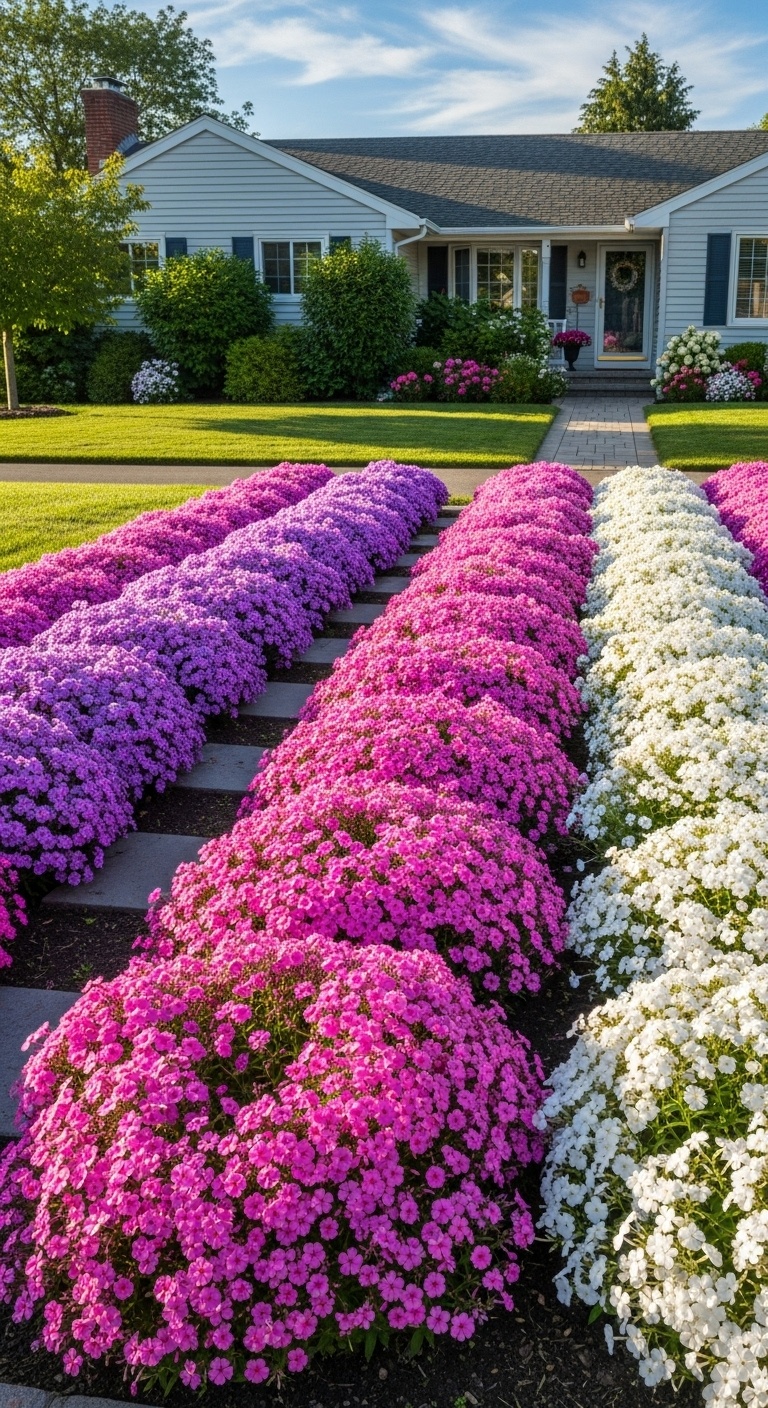
Phlox is a colorful addition to any flower bed in front of your house. These flowers bloom in various shades, including pink, purple, and white. They can brighten up your yard during the summer months.
These plants thrive in full sun and prefer moist, well-drained soil. They are great for attracting butterflies, adding a lively touch to your garden.
You can choose between tall varieties for a back border or shorter ones for the front of the bed. Phlox looks lovely when planted in groups, creating a striking visual effect.
To keep your phlox healthy, ensure they get enough water, especially during dry spells. Regular deadheading helps them bloom longer throughout the season.
“Phlox can thrive in various conditions, but they love full sun. Keep them well-watered, and you’ll enjoy their vibrant blooms all summer!” – MrPlanter
16. Coreopsis
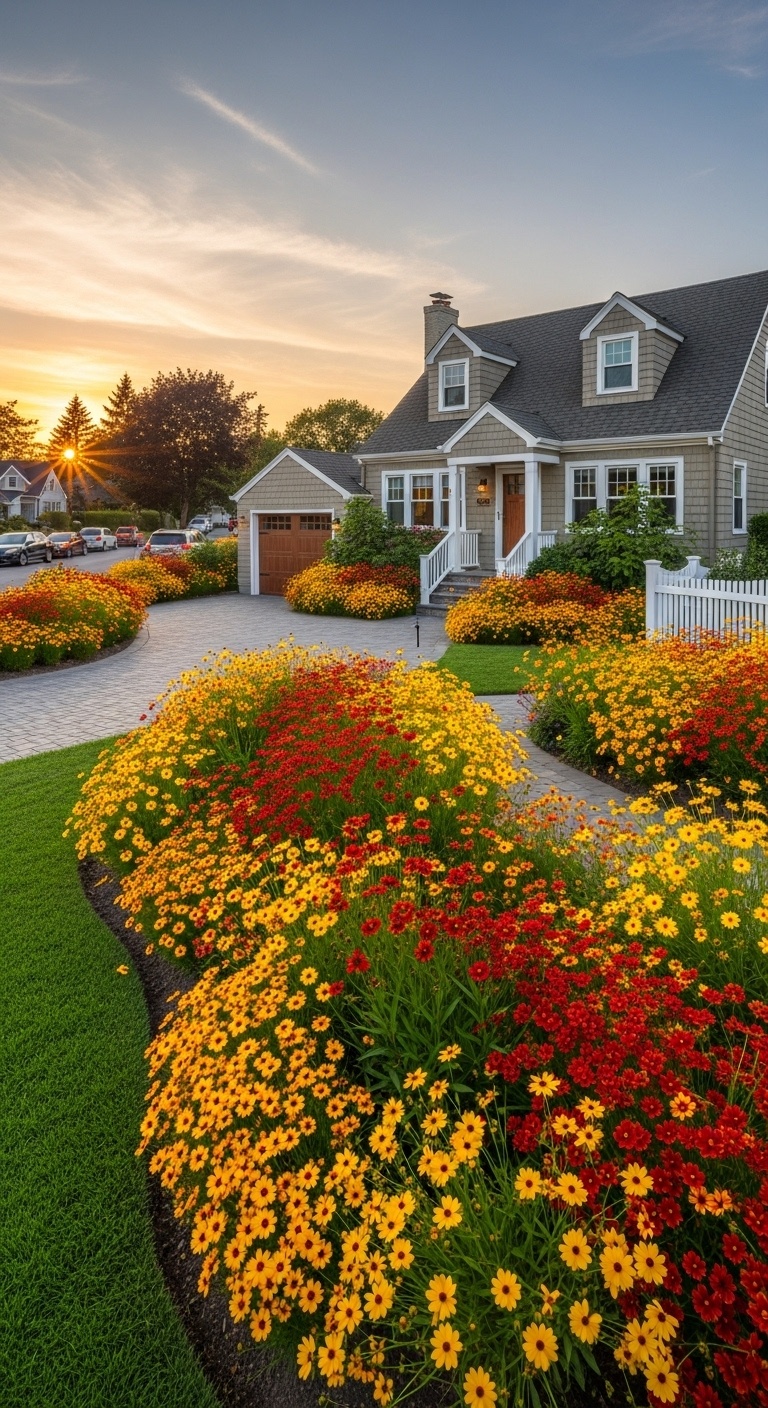
Coreopsis, also known as tickseed, is a lively flower that can brighten your front yard. With their bright yellow blooms, they add cheerful color from late spring to early fall.
These flowers are easy to care for and thrive in full sun. They prefer well-drained soil and can tolerate drought, making them perfect for low-maintenance gardens.
Coreopsis also attracts butterflies, adding even more life to your outdoor space. You can plant them in clusters for a bold look or mix them with other flowers for a diverse display.
“Coreopsis thrives on neglect, so don’t worry too much! Just give them sun and some space to grow.” – MrPlanter
17. Salvia
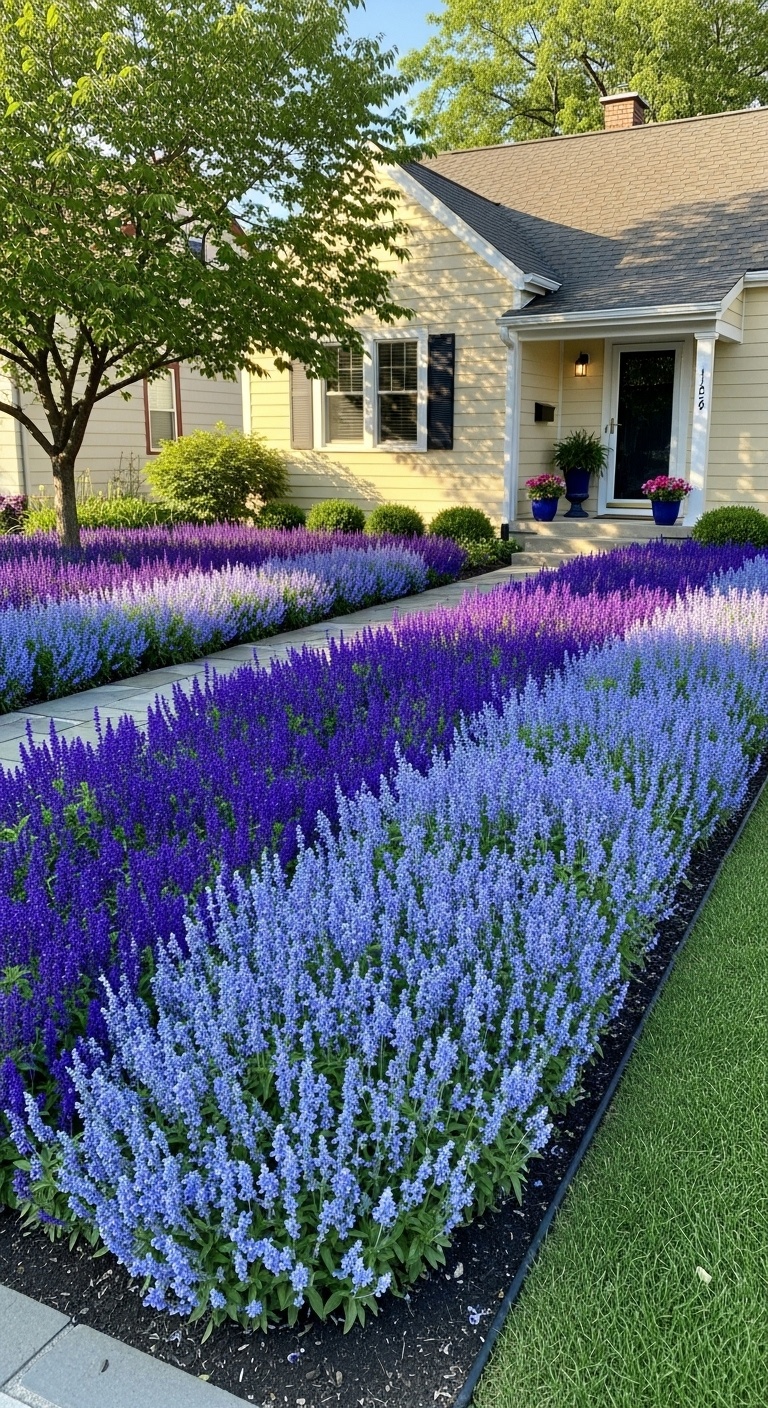
Salvia, commonly known as Sage, is an exceptional choice for front-of-house flower beds, bringing a burst of color and a magnet for pollinators like bees and hummingbirds.
These versatile perennials and annuals produce striking spikes of flowers, often in brilliant shades of blue, purple, pink, red, or white, creating a captivating visual display throughout the growing season.
Salvia varieties are generally low-maintenance and thrive in full sun, though some can tolerate partial shade. They prefer well-drained soil and are remarkably drought-tolerant once established, making them an ideal option for busy gardeners or those in drier climates.
Plant them in clusters to maximize their impact and enjoy their continuous blooms from late spring until frost. Their aromatic foliage also adds another layer of sensory appeal to your garden.
“For a vibrant, long-lasting display that actively supports local wildlife, Salvia is an outstanding addition to any sunny front flower bed.”
18. Astilbe
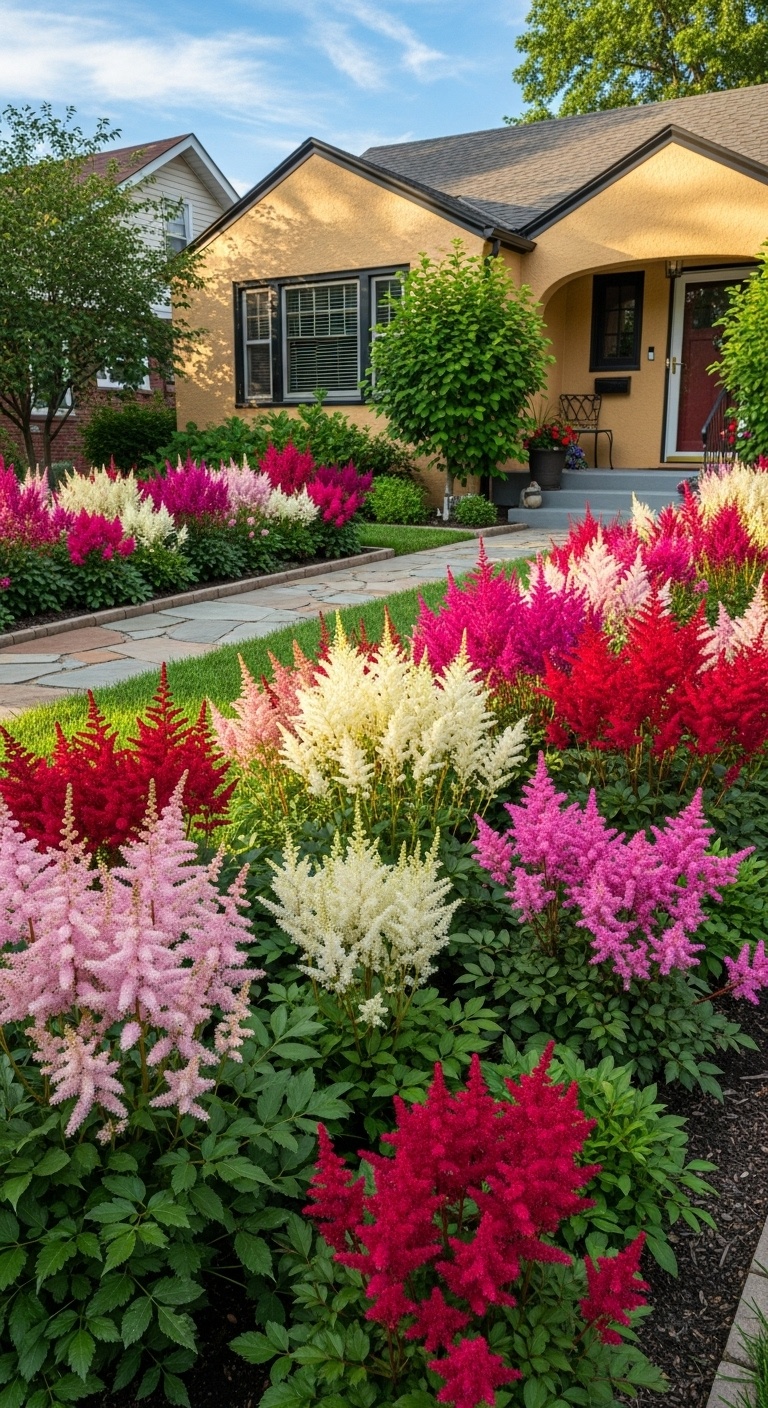
Astilbe is a great choice for your front flower bed. These plants love shade and add a soft, lush look to any garden. They bloom in colors like pink, white, and purple, providing a colorful pop.
Astilbe prefers moist soil, so it’s perfect for areas that stay a bit damp. They grow best in well-drained spots but can thrive with some water, making them easy to care for.
These plants can reach heights of 1 to 4 feet, depending on the variety. They also attract butterflies, adding life to your garden.
“Choose a spot with morning sun and afternoon shade for the best blooms. Regular watering will help keep your Astilbe thriving.”
19. Echinacea
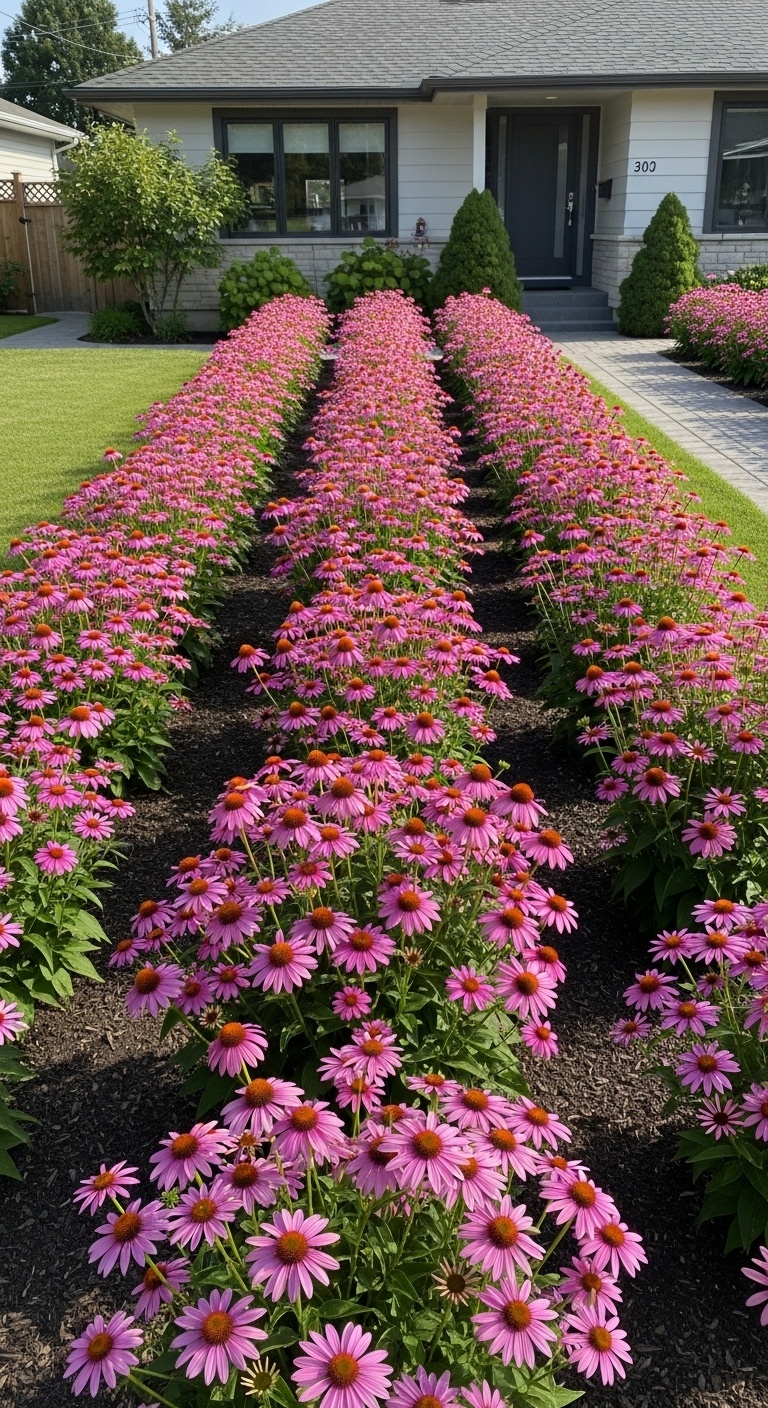
Echinacea, also known as coneflower, is a great choice for your flower beds. These hardy perennials come in lovely pink and purple hues. They can grow up to 3 feet tall and attract bees and butterflies.
You can pair Echinacea with other companion plants like lavender and yarrow. These plants help bring in more pollinators. They also keep pests away and can even help reduce weeds.
Make sure to plant Echinacea in well-drained soil and avoid areas that get too wet. They prefer full sun but can tolerate light shade.
To keep your Echinacea healthy, space the plants about 1 to 3 feet apart. Water them well and add a layer of mulch to retain moisture.
“Echinacea thrives on neglect, making it perfect for busy gardeners. Just plant them and enjoy the natural beauty they bring!”
20. Snapdragons

Snapdragons are a fantastic choice for your flower beds. They come in many colors and bloom in tall spikes, adding height and beauty to your garden. These flowers can reach from 6 to 36 inches, depending on the variety you choose.
You can plant snapdragons alongside companion plants like petunias and alyssum. They not only look great together but also help create a healthy garden by suppressing weeds.
Snapdragons prefer moderate temperatures and bloom best in spring and fall. Make sure to fertilize them with a balanced mix to support their growth. Using good-quality potting soil is key if you’re planting in containers.
“For the best results, water your snapdragons regularly but avoid getting the leaves wet. This helps prevent diseases and keeps them blooming beautifully.” – MrPlanter
21. Impatiens
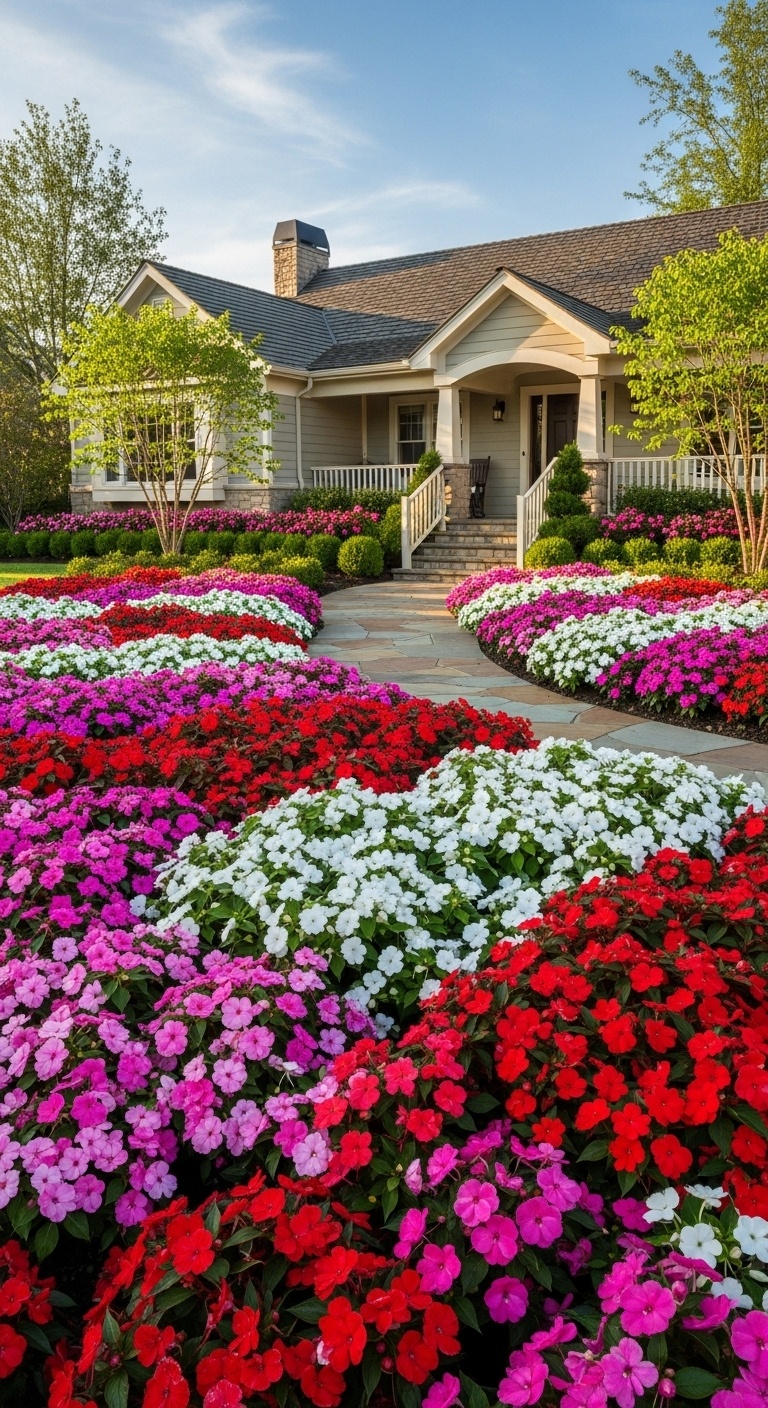
Impatiens are a great choice for your front flower bed. They offer vibrant colors and can thrive in shady spots. You can find them in red, pink, purple, and white.
When planting, wait until after the last frost. Dig a hole the size of the pot and gently loosen the roots before placing the plant.
Space the plants about 6 to 12 inches apart. This helps them spread out nicely without crowding each other.
Keep the soil moist but not too wet. Regular watering will keep your impatiens looking their best.
“Choose a mix of colors to create a cheerful display. They’ll brighten up your entrance and bring joy every time you come home.”
Choosing The Right Flowers
Selecting the right flowers for your front yard can make a big difference in your home’s appeal. Think about the types of plants that will thrive in your area and how much care they will need.
Perennials vs. Annuals
When choosing flowers, it’s important to know the difference between perennials and annuals. Perennials are plants that come back year after year. They can save you money and time since you don’t need to replant them. Examples include daylilies and cone flowers.
On the other hand, annuals last for just one growing season. They bloom brightly but you’ll need to plant them each year. Common choices are petunias and marigolds. Using a mix of both can create a vibrant flower bed. Perennials provide a solid base while annuals can add fresh colors each year.
Considering Sunlight and Soil
Before planting, think about how much sunlight your flowers will get. Some flowers need full sun, while others thrive in partial shade.
For example, zinnias love sun, while ferns prefer shaded areas.
Soil matters too. Test your soil to find out if it’s sandy, clay, or loamy. Each type supports different plants.
For example, geraniums prefer well-drained soil, while astilbes like more moisture.
Designing Your Flower Beds
Creating attractive flower beds requires careful planning. Focusing on color schemes, themes, and varying plant heights can help create a beautiful and inviting front yard.
Color Schemes and Themes
Choosing the right colors can make or break your flower bed. You might want to consider these popular schemes:
- Monochromatic: Use different shades of one color for a cohesive look.
- Complementary: Pair colors opposite each other on the color wheel, like blue and orange, for a vibrant effect.
- Analogous: Select colors next to each other, such as yellow, orange, and red, for a harmonious blend.
Incorporating a theme can also enhance your flower bed. Think about a tropical retreat with bright, bold colors, or a classic English garden with soft pastels and lush greens.
Use diverse plants that fit your chosen theme. This approach will make your front yard stand out.
Layering and Height Variations
Layering plants is key to creating depth. Start with taller plants at the back and work down to shorter ones at the front. Here’s a simple way to plan:
- Back: Use tall plants like sunflowers or delphiniums.
- Middle: Add medium-height options like daylilies or echinacea.
- Front: Finish with low-growing flowers such as pansies or petunias.
Mixing heights not only makes your flower bed visually interesting but also helps draw the eye across it.
Adding ground covers between taller plants can fill in gaps and provide a lush look. Using this layering technique ensures that each flower has its moment to shine, creating a balanced display.
